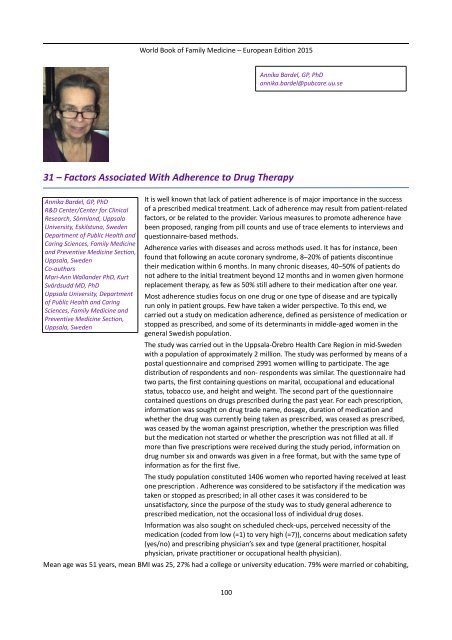Family Medicine
World Book 2015
World Book 2015
You also want an ePaper? Increase the reach of your titles
YUMPU automatically turns print PDFs into web optimized ePapers that Google loves.
World Book of <strong>Family</strong> <strong>Medicine</strong> – European Edition 2015<br />
Annika Bardel, GP, PhD<br />
annika.bardel@pubcare.uu.se<br />
31 – Factors Associated With Adherence to Drug Therapy<br />
Annika Bardel, GP, PhD<br />
R&D Center/Center for Clinical<br />
Research, Sörmland, Uppsala<br />
University, Eskilstuna, Sweden<br />
Department of Public Health and<br />
Caring Sciences, <strong>Family</strong> <strong>Medicine</strong><br />
and Preventive <strong>Medicine</strong> Section,<br />
Uppsala, Sweden<br />
Co-authors<br />
Mari-Ann Wallander PhD, Kurt<br />
Svärdsudd MD, PhD<br />
Uppsala University, Department<br />
of Public Health and Caring<br />
Sciences, <strong>Family</strong> <strong>Medicine</strong> and<br />
Preventive <strong>Medicine</strong> Section,<br />
Uppsala, Sweden<br />
It is well known that lack of patient adherence is of major importance in the success<br />
of a prescribed medical treatment. Lack of adherence may result from patient-related<br />
factors, or be related to the provider. Various measures to promote adherence have<br />
been proposed, ranging from pill counts and use of trace elements to interviews and<br />
questionnaire-based methods.<br />
Adherence varies with diseases and across methods used. It has for instance, been<br />
found that following an acute coronary syndrome, 8–20% of patients discontinue<br />
their medication within 6 months. In many chronic diseases, 40–50% of patients do<br />
not adhere to the initial treatment beyond 12 months and in women given hormone<br />
replacement therapy, as few as 50% still adhere to their medication after one year.<br />
Most adherence studies focus on one drug or one type of disease and are typically<br />
run only in patient groups. Few have taken a wider perspective. To this end, we<br />
carried out a study on medication adherence, defined as persistence of medication or<br />
stopped as prescribed, and some of its determinants in middle-aged women in the<br />
general Swedish population.<br />
The study was carried out in the Uppsala-Örebro Health Care Region in mid-Sweden<br />
with a population of approximately 2 million. The study was performed by means of a<br />
postal questionnaire and comprised 2991 women willing to participate. The age<br />
distribution of respondents and non- respondents was similar. The questionnaire had<br />
two parts, the first containing questions on marital, occupational and educational<br />
status, tobacco use, and height and weight. The second part of the questionnaire<br />
contained questions on drugs prescribed during the past year. For each prescription,<br />
information was sought on drug trade name, dosage, duration of medication and<br />
whether the drug was currently being taken as prescribed, was ceased as prescribed,<br />
was ceased by the woman against prescription, whether the prescription was filled<br />
but the medication not started or whether the prescription was not filled at all. If<br />
more than five prescriptions were received during the study period, information on<br />
drug number six and onwards was given in a free format, but with the same type of<br />
information as for the first five.<br />
The study population constituted 1406 women who reported having received at least<br />
one prescription . Adherence was considered to be satisfactory if the medication was<br />
taken or stopped as prescribed; in all other cases it was considered to be<br />
unsatisfactory, since the purpose of the study was to study general adherence to<br />
prescribed medication, not the occasional loss of individual drug doses.<br />
Information was also sought on scheduled check-ups, perceived necessity of the<br />
medication (coded from low (=1) to very high (=7)), concerns about medication safety<br />
(yes/no) and prescribing physician’s sex and type (general practitioner, hospital<br />
physician, private practitioner or occupational health physician).<br />
Mean age was 51 years, mean BMI was 25, 27% had a college or university education. 79% were married or cohabiting,<br />
100


